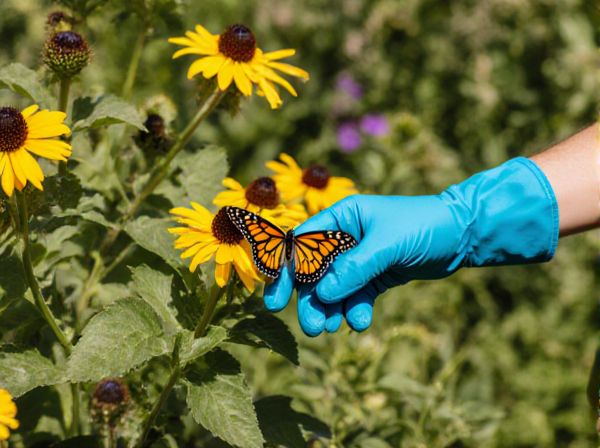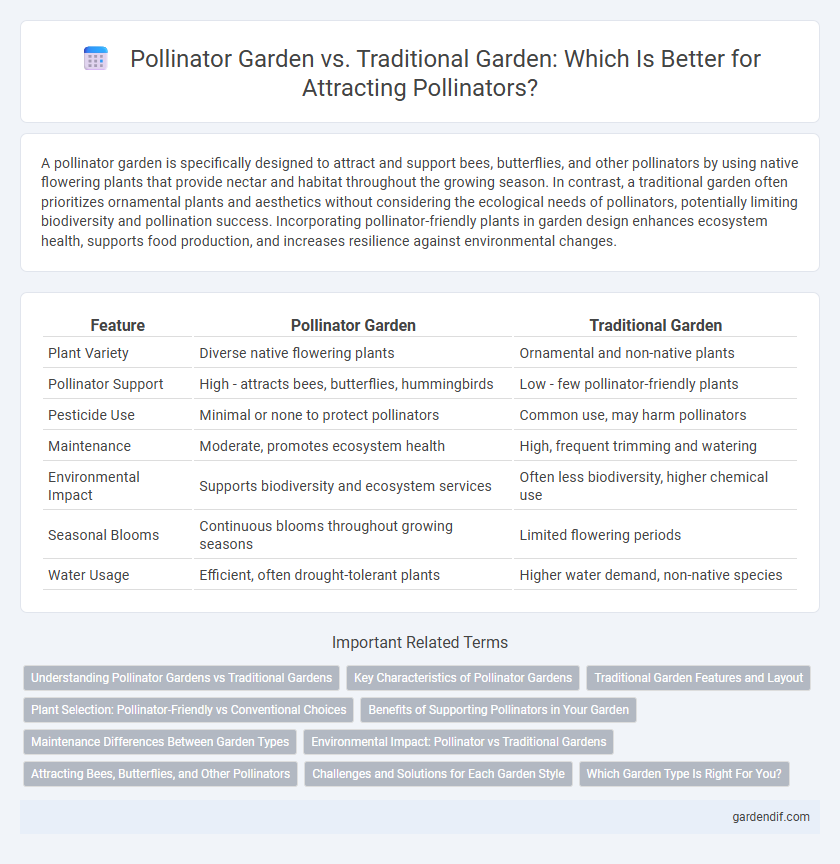
Pollinator garden vs Traditional garden Illustration
A pollinator garden is specifically designed to attract and support bees, butterflies, and other pollinators by using native flowering plants that provide nectar and habitat throughout the growing season. In contrast, a traditional garden often prioritizes ornamental plants and aesthetics without considering the ecological needs of pollinators, potentially limiting biodiversity and pollination success. Incorporating pollinator-friendly plants in garden design enhances ecosystem health, supports food production, and increases resilience against environmental changes.
Table of Comparison
| Feature | Pollinator Garden | Traditional Garden |
|---|---|---|
| Plant Variety | Diverse native flowering plants | Ornamental and non-native plants |
| Pollinator Support | High - attracts bees, butterflies, hummingbirds | Low - few pollinator-friendly plants |
| Pesticide Use | Minimal or none to protect pollinators | Common use, may harm pollinators |
| Maintenance | Moderate, promotes ecosystem health | High, frequent trimming and watering |
| Environmental Impact | Supports biodiversity and ecosystem services | Often less biodiversity, higher chemical use |
| Seasonal Blooms | Continuous blooms throughout growing seasons | Limited flowering periods |
| Water Usage | Efficient, often drought-tolerant plants | Higher water demand, non-native species |
Understanding Pollinator Gardens vs Traditional Gardens
Pollinator gardens are designed to support bees, butterflies, and other pollinating species by incorporating native flowering plants that provide nectar and habitat, enhancing biodiversity and ecosystem health. Traditional gardens often prioritize aesthetics or edible plants but may lack the specific floral diversity and nesting resources essential for pollinator survival. Emphasizing plant variety, seasonal blooms, and chemical-free practices distinguishes pollinator gardens as crucial for sustaining pollinator populations compared to conventional garden designs.
Key Characteristics of Pollinator Gardens
Pollinator gardens feature diverse native flowering plants that provide continuous nectar and pollen sources throughout the growing season, unlike traditional gardens that often prioritize aesthetics over ecological function. These gardens incorporate structural variety such as layers of plants, including trees, shrubs, and herbaceous species to support a wide range of pollinators like bees, butterflies, and hummingbirds. Pollinator gardens avoid pesticides and provide habitat features such as bare soil or nesting materials essential for pollinator reproduction and survival, distinguishing them from conventional garden practices.
Traditional Garden Features and Layout
Traditional garden features include symmetrical layouts, neatly trimmed hedges, and expansive lawns designed primarily for aesthetic appeal rather than ecological function. The structured arrangement often emphasizes ornamental plants and annual flowers, with minimal focus on supporting pollinator habitats or native plant diversity. Such gardens typically rely on regular maintenance routines, including pesticide use and frequent watering, which can inhibit pollinator activity and reduce biodiversity compared to pollinator gardens.
Plant Selection: Pollinator-Friendly vs Conventional Choices
Pollinator gardens prioritize native, nectar-rich plants such as milkweed, coneflowers, and bee balm that support bees, butterflies, and other pollinators, enhancing biodiversity and ecosystem health. Traditional gardens often feature non-native or ornamental plants with limited nectar or pollen, providing minimal benefits to pollinator populations. Selecting pollinator-friendly plants promotes sustainable garden ecosystems and contributes to pollinator conservation efforts.
Benefits of Supporting Pollinators in Your Garden
Supporting pollinators in your garden enhances biodiversity by attracting bees, butterflies, and other beneficial insects crucial for ecosystem health. Pollinator gardens improve crop yields and plant reproduction, ensuring sustainable food production and vibrant floral displays. Unlike traditional gardens, they require fewer chemical inputs, promoting a healthier environment and reducing pollution.
Maintenance Differences Between Garden Types
Pollinator gardens require less frequent mowing and selective weeding to maintain native flowering plants, promoting biodiversity with minimal chemical use, unlike traditional gardens that often rely on regular fertilization, herbicides, and intensive watering schedules. The natural mulch layers in pollinator gardens help retain soil moisture and suppress weeds, reducing overall maintenance efforts compared to conventional lawns or flower beds. Seasonal pruning in pollinator gardens is targeted to enhance bloom cycles and habitat structures, whereas traditional gardens typically demand more uniform and frequent trimming to maintain aesthetic formality.
Environmental Impact: Pollinator vs Traditional Gardens
Pollinator gardens significantly enhance biodiversity by providing essential habitats for bees, butterflies, and other pollinators, which are crucial for ecosystem health and food production. Traditional gardens often rely on non-native plants and chemical pesticides that can reduce pollinator populations and harm local wildlife. By promoting native flora and avoiding harmful chemicals, pollinator gardens support soil health, reduce runoff pollution, and contribute to climate resilience.
Attracting Bees, Butterflies, and Other Pollinators
Pollinator gardens feature native flowering plants that provide continuous bloom cycles, offering essential nectar and pollen sources that attract bees, butterflies, and other pollinators more effectively than traditional gardens. Incorporating a diverse array of colors, shapes, and blooming times creates a habitat that supports a wider range of pollinator species year-round. Unlike conventional gardens that often use non-native plants and chemicals, pollinator gardens foster a healthier ecosystem by minimizing pesticides and promoting biodiversity.
Challenges and Solutions for Each Garden Style
Pollinator gardens face challenges such as maintaining diverse native plant species and controlling pesticide use to support pollinator health, which can be mitigated through careful plant selection and organic gardening practices. Traditional gardens often struggle with limited biodiversity and reliance on chemical fertilizers and pesticides, negatively impacting pollinators; adopting integrated pest management and incorporating flowering plants can address these issues. Both garden styles require ongoing monitoring and adaptation to balance aesthetics, plant health, and ecological benefits for optimal pollinator support.
Which Garden Type Is Right For You?
Pollinator gardens prioritize native flowering plants that attract bees, butterflies, and other beneficial insects, enhancing biodiversity and supporting local ecosystems, while traditional gardens often emphasize aesthetic uniformity with non-native species and ornamental plants. Choosing the right garden depends on your goals: if you want to promote environmental health and contribute to pollinator conservation, a pollinator garden is ideal; if you prefer low-maintenance landscapes prioritizing decorative appeal, a traditional garden may fit better. Consider factors such as local climate, available space, and desired plant types to create a garden that aligns with your environmental impact and aesthetic preferences.
Pollinator garden vs Traditional garden Infographic

 gardendif.com
gardendif.com